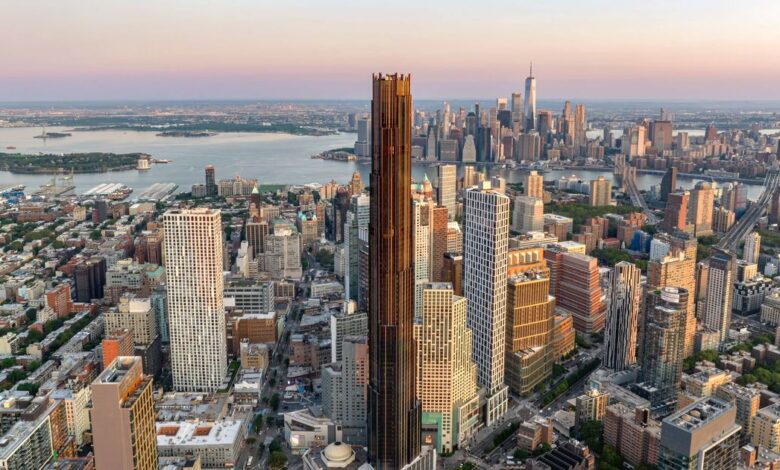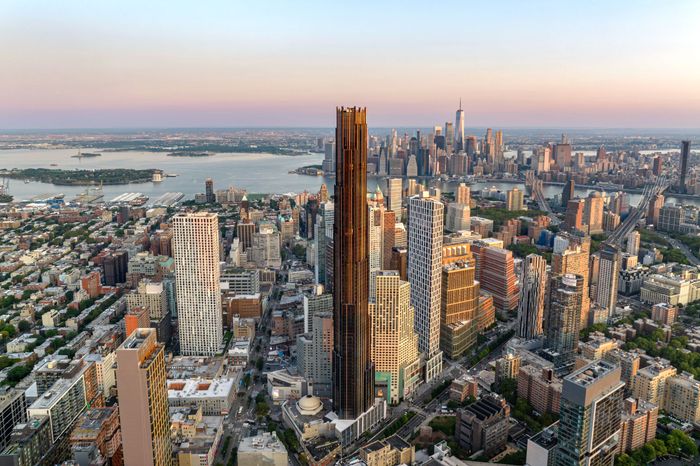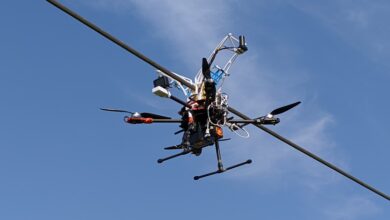Brooklyn Tower Is Facing Foreclosure


Brooklyn Tower, as shown in this photo from StreetEasy, has become the most recognizable feature of the Brooklyn skyline, with a design that some consider striking or others ominous.
Photo: Douglas Elliman
When Brooklyn Tower topped out in October 2021, Michael Stern threw a party. As sunset approached, staff herded guests milling around the lavishly ornamented rotunda of the Dime Savings Bank into construction elevators for a toast at the top of the 1,066-foot building that was now, officially, historically, the city’s only supertall outside of Manhattan. It had taken years of wrangling, but Stern, founder and managing partner of JDS Development, was now standing above the city, wind whipping through the open sides of his building, as his guests exclaimed over the view and edged up to the construction netting for selfies. I remember him toasting Gregg Pasquarelli, founding principal of SHoP Architects, which designed the building, and also himself, for daring to believe in New York and its future at a time when so many people had fled. But two and half years later, the mood at Brooklyn Tower had dimmed. At the end of March, Larry Silverstein’s Silverstein Capital Partners, the mezzanine lender, which gave Stern a $240 million loan in 2019, moved to foreclose.
Stern’s supertall at 9 Dekalb, with its strikingly dark neo-Gothic façade, is now the most recognizable feature in the Brooklyn skyline — and perhaps its most divisive. But people in the real-estate industry have always talked about it for a different reason, with some speculating it was doomed from the start — its super tall, super skinny design better suited to Billionaires’ Row, the kind of rarified, globe-trotting enclave preferred by the people who could pay the kind of prices a project like this would need to break even. “It’s one thing to pay a premium to be 1,000 feet above Central Park,” a source who works in development tells me, “but 1,000 feet above Trader Joe’s?”
Stern, now 44, rose in the span of decade from a workaday outer-borough developer to Manhattan’s top-flight tier, building technically complex skyscrapers for the billionaire class. He’s known for both his showboating — private jets, Prada sneakers, collecting rare sports cars — and the glittery ambition of his projects. He converted a Verizon office building in Chelsea into Walker Tower, burnishing the reputation of the fairly obscure Art Deco architect who’d designed it to sell $9 million condos to the likes of Cameron Diaz. He tapped SHoP, a buzzy rising-star firm, to design the American Copper buildings in Murray Hill, a pair of red-gold towers connected by a skybridge in a neighborhood known mostly for unremarkable rentals favored by recent college grads. He built the skinniest of the Billionaires’ Row supertalls, 111 West 57th Street, on a teeny-tiny site above the landmarked Steinway Hall, a project that went into foreclosure and racked up lawsuits, the details of which the Financial Times once described as “baroque.” (“Litigation is inevitable in this business,” he told the paper. “If you’re not being sued by people, you’re not doing enough work.”)
Brooklyn Tower was similarly audacious: a decidedly Manhattan sensibility — and pricing, averaging $2,300 per square foot — on Flatbush Avenue. Stern acquired the site nearly a decade ago, with Joseph Chetrit, whom he later bought out. (Although, it seems, not on the timeline they’d agreed to — Chetrit sued in 2022, alleging that Stern still owed him $17 million.) “We’re really excited to give Brooklyn a building that isn’t bashful, that isn’t shy,” Stern said back in 2016, when the developers filed plans with the city. “We want this project to encapsulate everything that is great about Brooklyn’s past and everything that is great about Brooklyn’s future.” The tower, one of the last projects to get a 421-a tax abatement, was designed to have a mixture of retail, rental and condo units — 150 condos and 400 rentals, respectively, with 30 percent of the latter set aside as affordable. Amenities include an open air basketball court on the 66th floor and two pools, one of which was to wrap around the dome of the Dime Savings Bank.
But the project was also complex and expensive. Supertalls are more involved from an engineering perspective, and, with a lot of valuable real estate eaten up by elevator banks, it’s harder to make pencil out. While a super-skinny supertall could command $6,000 per square foot or more on West 57th Street, it wasn’t obvious that a supertall in Downtown Brooklyn could get even a third of that. “It was hard to see how the economics of that building were ever going to work out,” a development source tells me. “It’s so freaking tall, it’s inefficient.” Land is cheaper, he continued, but everything else — the labor, the construction, the soft costs — are the same. (The fact that it’s attached to the landmarked Dime Savings Bank adds allure, but also complications — and costs.) Brooklyn Point and 11 Hoyt are also new, tall, luxury towers in the neighborhood, but it’s precisely because they don’t soar to the same lofty heights as Brooklyn Tower that they don’t have to trade for nearly as much to break even. (And mostly haven’t — the median closing price at 11 Hoyt is $1,465 per square foot, according to StreetEasy, while Brooklyn Point is getting an average of $1,841.)
Stern was undeterred. In the summer of 2019, JDS closed on construction financing — $240 million from Silverstein and $424.1 million from Otéra Capital Inc. The deal came at a time when banks, fearing a glut, were cooling on the high-end apartment market, leaving a hole increasingly filled by private lenders. Mezzanine financing comes in when a developer can’t get all their costs covered by a traditional loan and must find a way to fill the hole, and it was Silverstein’s first such loan. While mezzanine financing often comes from hedge funds and other lenders that are neither capable nor interested in taking over a project if the developer defaults, Silverstein, who developed one of the World Trade Center sites, was clearly not put off by the prospect. When the financing was finalized in 2019, the lending arm’s president told the Wall Street Journal that the project’s complexity was the appeal: “The thing that attracted us to it is the same thing that scares others.”
Joshua Stein, a real-estate lawyer who handles commercial financing, says that developers have increasingly gone into making mezzanine loans not only because of the nice return on their money, but also because “if a borrower defaults, they’re happy to go in and take over.” That’s a big difference from a typical hedge fund or traditional bank, which has neither the expertise nor the desire to take on a complicated project. “Bank of America, that’s the last thing they want,” he says.
And if the borrower defaults, a foreclosure can happen fast. While mortgage lenders have to go through yearslong judicial foreclosure, a mezzanine loan is backed, not by the building itself, but by equity interests in the LLC that owns the building. Simply put, it’s faster and more efficient to foreclose — the auction for 9 DeKalb’s has been scheduled for June 10. Adding to the possible intrigue: Late last year, Silverstein bought the mortgage from Otera for $428.5 million, so it now holds mortgage, and junior, senior mezzanine loans. “Larry has the mezz and the first position mortgage?” says a source who works in development. “He’s looking to take the building.” Another real estate insider tells me: “It’s a power move.” (JDS declined to comment. Silverstein released a statement saying 9 DeKalb’s mezzanine and mortgage loans were in maturity default and Silverstein, as the junior mezzanine lender, was doing what it is legally entitled to do.) Stern is hardly the only borrower who’s in a tough position right now, says Jonathan Squires, a managing director in the Investment Sales Group of Cushman & Wakefield — a lot of projects that have had loans come due are in trouble.
The building’s first renters started moving in last spring, which was also around the same time that JDS put the rental and retail portion of the building on the market. They were said to be aiming for $600 to $700 million, the Real Deal reported at the time. The price was widely considered steep — more in line with what it would have fetched before interest-rate hikes cooled the multifamily market — and no buyers emerged. It is no longer on the market. A real estate source said it was likely harmful to sales and leasing when JDS put the rental retail component up for sale because the building started to seem distressed. Life Time Fitness, the only gym fancier than Equinox, as one of my colleagues noted, has taken most of the 130,000 retail space at the base. Rumors abound as to what will be done with the Dime Savings Bank — Apple store? Concept restaurant? — but so far, nothing has been announced.
And while sales launched at the building two years ago, and people with knowledge of the project estimated that it was 30 to 40 percent sold, public records show that just 18 of 148 condos have closed so far. The consensus is that apartments are selling for good prices, there just hasn’t been that many sales. “It’s not like Brooklyn Tower has sold nothing,” a real-estate source says. “They get high prices, just not quickly enough.”
And in the end, moving a few more apartments wouldn’t solve Stern’s financing puzzle. So will he spin out on Brooklyn Tower? It’s hard to say. To fend off the foreclosure, Stern would have to refinance and refinancing didn’t strike a lot of people I spoke with as likely, but it could happen. (It’s a rough time to be doing it.) A lawsuit or bankruptcy could also buy time. But no matter what happens at Brooklyn Tower, no one thinks it’s the end of Michael Stern, who is already on to his next supertall — a Dolce & Gabbana–branded Miami tower with Tal and Oren Alexander of OFFICIAL are handling sales. Real-estate developers famously have many lives — someone joked to me that Stern had 27 of them at 111 West 57th Street alone. Or as another put it: “He’s a very clever guy.”




